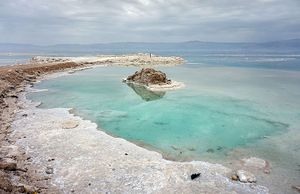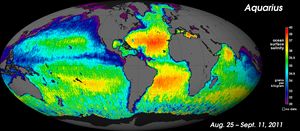Ocean salinity

"Ocean Salinity" refers to the total amount of dissolved solids present in seawater, commonly expressed as as a percentage or in parts per thousand. The salinity of the oceans arises from the fact that every mineral on Earth dissolves into water at an equilibrium ratio dependent upon the water acidity and temperature.[2] As a general rule the solubility of most rocks and minerals increases with temperature, salinity is lower in colder parts of the ocean and higher in warmer parts.[3] The average global ocean salinity is around 35 parts per thousand, or 3.5%.[4]
In certain situations, highly saline lakes can also form on land. They occur when water falls onto a catchment that has no outflow to an ocean basin. The water will instead pool in the lowest point of the basin and begin evaporating, which increases the salinity of the water body as dissolved salts cannot evaporate. This is the phenomenon responsible for the Dead Sea in Israel, which has a salinity of almost 340 parts per thousand,[5] see figure 1.

Density Dependent Flow
Spatial differences in ocean salinity alongside temperature are responsible for driving some of the largest ocean currents in existence. The North Atlantic Deep Water (NADW) is a salinity dependent process that forms part of the thermohaline circulation (THC) current in the north Atlantic.[7] It is here where ocean waters in the north are cooled to temperatures below 0°C, which forms sea ice at surface and produces extremely cold, salty brine waters that were expunged from the sea ice. These cold, briny waters have a greater density than the surrounding waters due to their elevated salinity, and thus sink down to the bottom of the ocean. This convective process helps to drive the ongoing circulation of Earth's oceans[8].
Paleosalinity
The salinity history of Earth's past oceans is an area of active reserach, but recent advances in isotopic analyses of carbonate rocks have helped to constrain the range of possible changes in ocean salinity. As Earth's oceans have changed in pH and temperature throughout millennia, so too has their ability to dissolve minerals. The salinity of the Atlantic ocean during the last glacial period from 60,000 to 11,000 years ago was found to be higher on average than the salinity of the modern day.[9] This is thought to be a result of locking large volumes of water on land through the formation of the Northern hemisphere ice sheets, removing water from the oceans but allowing them to retain the dissolved minerals, as dissolved constituents do not leave the reservoir during evaporation.
Impacts from Climate Change
Rising sea levels resulting from anthropogenic climate change are expected to produce significant impacts on coastal regions through the phenomenon of salt water intrusion, whereby elevated ocean levels force the mixing line between fresh and saline waters to retreat inland further up rivers, fjords, and other freshwater inlets into the sea.[10] The projected increase in evaporation about the tropics is projected to produce increases in ocean salinity about the tropics, and increases in temperature in the Northern parts of the Atlantic could slow down or stop the formation of the cold brine waters that drive the THC in the North Atlantic Deep Water. This is expected to preclude rapid shifts in the North American climate regime, as ocean circulation plays a key role in distributing heat throughout the globe.[11]
References
- ↑ Wikimedia Commons (June 11, 2020). Dead Sea ShoreTiia Monto.
- ↑ Wolff T. et al. (1999() On the Reconstruction of Paleosalinities. In Fischer G., Weer G. (eds) Use of Proxies in Paleoceanography. Springer, Berlin, Heidelberg
- ↑ Pawlowicz, Rich (May 27 2020). "Key Physical Variables in the Ocean: Temperature, Salinity, and Density" [Online]. Accessible: https://www.nature.com/scitable/knowledge/library/key-physical-variables-in-the-ocean-temperature-102805293/
- ↑ Science Learning Hub (may 27 2020). "Ocean Salinity" [Online]. Accessible: https://www.sciencelearn.org.nz/resources/686-ocean-salinity
- ↑ Encyclopedia Britannica (May 29 2020). "Dead Sea" [Online]. Accessible: https://www.britannica.com/place/Dead-Sea
- ↑ NASA/GSFC/JPL-Caltech (September 11, 2011). NASA's 'Salt of the Earth' Aquarius Reveals First Map [Online]. Accessible: https://www.jpl.nasa.gov/spaceimages/details.php?id=pia14786
- ↑ Stefan Rahmstorf (2006). 'Thermohaline Ocean Circulation [Online]. Accessible: http://www.pik-potsdam.de/~stefan/thc_fact_sheet.html
- ↑ National Ocean Service (June 12, 2020). Thermohaline Circulation. [Online]. Accessible: https://oceanservice.noaa.gov/education/tutorial_currents/05conveyor1.html
- ↑ National Science Foundation (June 9, 2020). Researchers Link Ice-Age Climate-Change Records to Ocean Salinity [Online]. Accessible: https://www.nsf.gov/news/news_summ.jsp?cntn_id=108053
- ↑ Wood C, Harrington GA. Influence of seasonal variations in sea level on the salinity regime of a coastal groundwater-fed wetland. Ground Water. 2015;53(1):90‐98. doi:10.1111/gwat.12168 [Online]. Accessible: https://pubmed.ncbi.nlm.nih.gov/24571421/
- ↑ Muschitiello, F., D'Andrea, W.J., Schmittner, A. et al. Deep-water ciruclation changes lead North Atlantic climate during deglaciation. Nat Commun 10, 1272 (2019). https://doi.org/10.1038/s41467-019-09237-3. [Online]. Accessible: https://rdcu.be/b4RZJ

